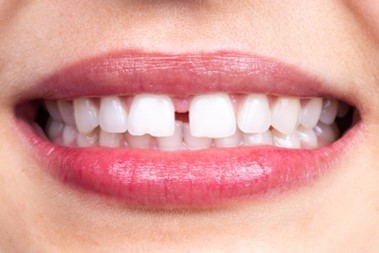
A common issue many people encounter is having a gap between their front teeth, known as diastema. This gap can occasionally affect a person’s confidence and self-esteem. Fortunately, cosmetic dentists provide various solutions to address this concern, including dental bonding, veneers, and orthodontic procedures. These treatments are not only safe and successful but also provide long-lasting results. Continue reading as we delve into how a cosmetic dentist can identify the best solution for your specific needs.
6 Causes of a Diastema?
A diastema is a noticeable gap, typically exceeding 0.5 millimeters, that can form between two adjacent teeth. Although it is commonly observed in children, there is no assurance that it will naturally close over time. Several factors can play a role in the emergence of this gap, including:
- Tooth loss – The loss of primary (baby) teeth, in particular, can lead to a gap between the two front teeth.
- Untreated gum disease – Gum infections that are left untreated can result in a gap forming in between teeth due to tooth shifting, gum recession, or tooth loss.
- Incorrect swallowing reflex – A flawed swallowing reflex may exert force on the front teeth, leading to their gradual separation and the formation of a gap.
- Labial frenum – The labial frenum, which is the tissue that extends from the upper lip to the gums above the upper front teeth, has the potential to cause an increased space between the two front teeth.
- Poor oral habits – These include smoking and the practice of biting on hard objects.
- Tooth size – The dimensions of the teeth in relation to the jaw, including instances of missing or undersized teeth, can play a role in the formation of a diastema.
How Are Diastemas Treated?
Identifying a diastema is typically uncomplicated and can be done as part of a regular dental checkup. Treatment is not always essential, especially when it arises from natural factors like jawbone size or the shedding of baby teeth. However, although a diastema may not always require intervention, leaving it unattended can increase the risk of plaque buildup, gum disease, and enamel erosion.
Treatment choices for diastemas include braces, veneers, and dental bonding. The choice of the most appropriate treatment depends on each patient’s specific situation. Invisalign is a commonly used orthodontic solution, but dental bonding and veneers are equally effective options to address diastemas.
When diastemas result from missing teeth, more complex remedies like dental bridges, dentures, or implants may be necessary. If gum disease is associated with the condition, periodontal therapy is the advised course of action. In cases where an oversized labial frenum is the root cause, surgical intervention becomes essential.
About the Practice
Rauchberg Dental Group in Parsippany boasts a team of six highly skilled dentists committed to delivering thorough dental care. Their offerings span general, cosmetic, restorative, and emergency treatments. Alongside routine checkups and prompt emergency dental services, they provide solutions for closing gaps between teeth, including Invisalign, dental bonding, braces, and veneers. They also offer advanced procedures like dental implants and bridges. To book an appointment or learn more about their services, please contact Rauchberg Dental Group at (973) 718-9887 or visit their website.
